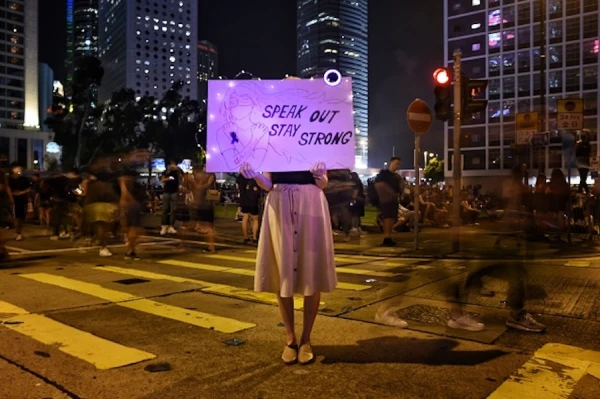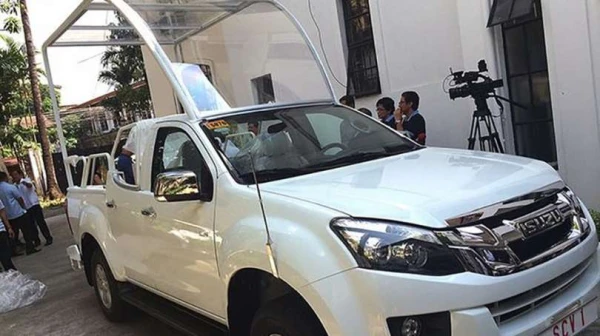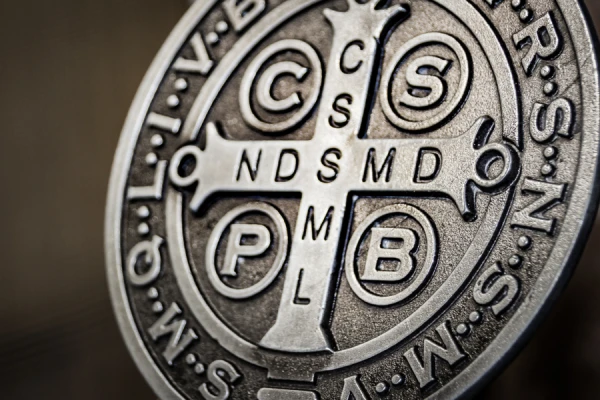
Hong Kong, China, Aug 28, 2019 / 06:05 pm (CNA).- The people of Hong Kong are no strangers to political protest.
Large-scale demonstrations have rocked the island territory since early June, when an estimated 1 million marchers took to the streets, chanting and singing.
The protests began as a response to a controversial bill, put forth in February by the government of chief executive Carrie Lam, which would have allowed the Chinese government to extradite alleged criminals from Hong Kong to stand trial on the mainland.
Protestors vehemently opposed the bill, sparking the first major protest on June 6.
Though Lam suspended the bill June 15 and even apologized, protestors feared that the proposal could be reintroduced. The next day, an estimated 2 million marchers were out on the streets.
The protests have since morphed to focus on actions by police that many have denounced as police brutality, including allegations of sexual assault by police officers. Protestors also have made calls for greater democracy in the territory and for Lam’s resignation.
The New York Times has noted that these protests have eclipsed the island’s next-longest set of protests in length, as the demonstrations have been going on for 80 days— longer than the 2014 pro-democracy “Umbrella Movement,” which also saw hundreds of thousands of citizens take to the streets.
Though the protests have been largely peaceful, participants on both sides have periodically resorted to violence.
Opposing mobs of protestors have occasionally clashed, resulting in injuries, and Hong Kong’s police fired a live round of ammunition for the first time during an Aug. 26 protest. The police also used water cannons to break up protestors for the first time, after having used tear gas and rubber bullets extensively in the past, which have led to numerous injuries.
The political situation, and the implications for what could happen next, are complex, and Catholics and Protestant Christians both young and old are making their voices heard amid the protests.
What is Hong Kong’s political context?
Hong Kong is what’s known as a special administrative region, meaning it has its own government but remains under Chinese control.
Hong Kong was a British colony until 1997, when it was returned to China under a “one country, two systems” principle, allowing it its own legislature and economic system. Chief Executive Carrie Lam is herself Catholic, BBC News reports.
The territory has seen numerous protests in recent years, most significantly in 2014, wherein citizens have demanded an expansion of democracy.
The current protests are the longest and largest in the territory’s history, and are not currently showing signs of abating.
What is it like for Catholics in Hong Kong?
Life for Catholics in Hong Kong vs in mainland China is very different. The island is only about 8% Catholic, but that represents a population of over half a million.
Hong Kong has total freedom of worship and evangelization, Father Bernardo Cervellera, editor of Asia News, told EWTN News Nightly recently, because for the past 50 years it has been a “liberal society” where the decisions of the dioceses are not subject to government control.
In mainland China, by contrast, there is a long history of persecution for Christians who run afoul of the government.
The U.S. Commission on International Religion wrote in its 2018 report that last year China “advanced its so-called ‘sinicization’ of religion, a far-reaching strategy to control, govern, and manipulate all aspects of faith into a socialist mold infused with ‘Chinese characteristics.’” Christians, Muslims, Tibetan Buddhists, and Falun Gong practitioners have all been affected.
A new bishop was consecrated this week in Inner Mongolia, China, becoming the first bishop to be consecrated in the country under a new deal signed between the Vatican and Beijing. The Vatican says the deal will lead to increased freedoms for Chinese Catholics, but some critics have been skeptical.
Why are the protests so significant for Christians?
Catholic leaders in Hong Kong have expressed concern that the Communist Chinese government would use the now-suspended extradition law to further tighten its grip on free speech and free exercise of religion in Hong Kong.
“The Chinese government is suppressing the Church in mainland China, and so we are worried that when we have communication with the mainland Church, maybe one day the Chinese government will also arrest the Hong Kong people to suppress Hong Kong people,” Edwin Chow, acting president of the Hong Kong Federation of Catholic Students, told CNA.
The apostolic administrator of Hong Kong, Cardinal John Tong, has asked the government to eliminate the extradition law completely, and for an independent inquiry into the excessive use of force by the Hong Kong police.
An oft-cited case is that of Lam Wing-kee, a Hong Kong bookseller who sold books critical of China’s leadership. Authorities arrested him as he crossed the border into mainland China in 2015.
Lam fears that the law could be used to control free speech in Hong Kong through fear that the Chinese would begin— legally— forcibly removing from Hong Kong those who express views they do not agree with.
“Beijing will use this [extradition] law to control Hong Kong completely,” Lam told ucanews.com in June.
“Freedom of speech will be lost. In the past, the regime kidnapped its critics, like me, illegally. With this law, they will abduct their critics legally.”
The issue of extradition has been a contentious one in the region for a number of years, as Hong Kong has no formal extradition deal with Taiwan, Macao, and mainland China, potentially creating legal loopholes in some circumstances.
Still, advocacy groups expressed worry that the law could endanger the freedom that Christians in Hong Kong currently enjoy.
“If the latest legislation was successful, those seeking refuge and freedom of conscience in Hong Kong could face extradition back to the mainland,” International Christian Concern (ICC), an advocacy group for persecuted Christians, said June 17.
Not all Christian groups oppose the legislation, however; Peter Douglas Koon, the Anglican provincial secretary-general of Hong Kong, supports the change, and the Anglican Church in Hong Kong has stated its position as being that offenders must be brought to justice by whatever means necessary, LaCroix International reports.
What have the protestors done?
Large groups of protestors, most of them young people, have used social media and private messaging apps such as Telegram to coordinate their rallies.
Most of the protests have taken place in public places, mainly on the streets. On Aug. 23, thousands of protestors formed a giant human chain across the city.
In mid-August, thousands of protestors filled the arrival and departure halls of the Hong Kong airport, disrupting service and at one point canceling 200 flights in one day.
Though the protests have been largely peaceful, participants on both sides have periodically resorted to violence.
On July 1, the 22nd anniversary of Hong Kong’s handover from Britain to China, protestors broke through into the territory’s legislature building where, per The New York Times, they painted slogans on walls and defaced symbols of Chinese authority.
In mid-July, protestors and police clashed in a shopping mall. Photographs from the scene shows umbrellas scattered everywhere.
Opposing mobs of protestors have occasionally clashed, resulting in injuries, and Hong Kong’s police fired a live round of ammunition for the first time during an Aug. 26 protest. The police also used water cannons to break up protestors for the first time, after having used tear gas and rubber bullets extensively in the past, which have led to numerous injuries. Police arrested 36.
Despite the threat of violence from police and growing concern about a potential crackdown by Chinese authorities, an estimated 1.7 million people took to the streets of Hong Kong the previous Sunday for a largely peaceful demonstration in the pouring rain.
Some protestors, marching Aug. 28, focused their message on opposing alleged sexual assaults by police against female protesters, and standing in solidarity with a woman who police allegedly shot in the eye with a rubber bullet.
What are Catholics saying and doing?
The Archdiocese of Hong Kong has released numerous statements decrying the violence and urging prayers for the protestors.
Chow has called the protests a “leaderless movement,” and said that many of the Catholic students join in the protests organized by others, but also arrange Masses and prayer vigils to go long with the marches.
Henry Au, an entrepreneur who serves on the board of directors for the Irish Chamber of Commerce for Hong Hong, told CNA in August that although he has only attended two or three of the actual marches, he has been trying to materially support the protestors however he can.
He said older Catholics are less likely to go and march in the street, but they are still able to assist by providing funds to hold Masses and buy protection gear for the protestors.
Many clergy have also been supportive.
Cardinal Joseph Zen, bishop emeritus of Hong Kong and a sharp critic of the Vatican-China deal, celebrated Mass on June 16 at the invitation of the Federation in front of the government headquarters.
Chow told CNA he would like to see Catholics and other Christians take on a larger role in ongoing protests against the government, amid fears of a crackdown by Chinese authorities.
“For this movement, it’s a great chance for the Catholics and [Protestant] Christians to cooperate with each other,” Chow told CNA on Aug. 16.
“It’s a good chance for us to become united. Because I think for most of the Catholics and Christians, we have the same values, the same goal…so that’s why we cooperate, and I think after Christians and Catholics cooperate, or strengths, our power becomes stronger.”
While Chow said that Christians, among them Catholics, had a more major role when the protests began— leading the singing of hymns such as “Sing Hallelujah to the Lord” in the streets during the protests, for example— their role has since diminished.
As the protests have continued, he said some participants became “more aggressive, more radical.” Chow said he thinks the protests have become more radical because even after two marches in June saw more than a million marchers, the government has still not answered the protestors’ demands.
Many of the protestors began to take action such as try to break into the legislative council building, or clash with police out of frustration.
What’s next?
Mainland China’s next move remains difficult to discern. After the violent Aug. 26 clash, Chinese state media used its “”harshest rhetoric yet to condemn the unrest and warned that Beijing could soon intervene, Time reports
A fleet of armored vehicles has been training at a sports stadium in Shenzhen, a mainland Chinese city not far from Hong Kong.
Chow told CNA that the next large protest is scheduled to take place Aug. 31. In addition, students are planning to strike on the first day of class, Sept. 2.
“For the Catholic groups, for the Christian groups, we have the responsibility and we have the power to calm our friends down. Because I think singing hymns, just in the beginning, it creates a peaceful atmosphere, and it has a power to keep everyone very calm. So I think we can use this when we do this again,” Chow said.
 […]
[…]






